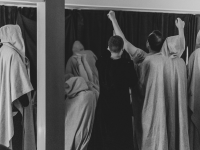This article was prompted by the recent republication on Nordiclarp.org of the article ‘Flagging is Flawed’ (Brown and Teerilahti 2024) from the Solmukohta 2024 book Liminal Encounters.
In the article, the authors describe the practice of circulating a list of names of participants prior to a larp event, and inviting ‘flagging’ – the indication of safety concerns about fellow-participants, privately to the organizers. They discuss problems that they perceive with the tool.
Our perception is that the article itself is flawed, because it doesn’t discuss the commonest flagging practices that are actually widely used in contemporary Nordic and international larp (in those cases when flagging is used at all).
The authors seem to assume that the only flagging indication possible is a ‘red flag’, meaning that the named person should be considered unsafe and should be prevented from attending the event. They go on to suggest that this is misapplied, with participants flagging for reasons other than serious and absolute safety concerns meriting a ban from the event.
That would indeed be a problem – which is why larp organizers don’t, in general, ask solely for red flags. Instead, they usually ask for a range of different indications of concern, with only the most severe meriting a red flag and hence exclusion.
For example, a ‘yellow flag’ is commonly used to indicate that one wishes to avoid playing closely with another person, but does not consider them a general danger. Brown and Teerilahti seem to be unfamiliar with this practice, or have chosen to ignore it for the sake of their thesis. Either way, it invalidates a large part of their argument, because in their article they seem to assume that flagging because of a wish not to play closely will necessarily lead to automatic removal of the flagged person from the larp. But in practice, larp organizers for the most part do not act in such a way: a yellow flag simply means that the flagger and the flagged person will be cast in roles that are not closely connected.
Some of the difficulties of communicating about flagging relate to its dual purpose. Red flags are intended as a safety tool – we want to keep people who have hurt others out of our larps. This is a method of mitigating risk at the events we run.
But organizers may also feel the need to offer a comfort tool. Casting two players who dislike each other in an intense relationship is likely to result in a poor larp experience for them, and perhaps for everyone else, too. Therefore it’s useful to have methods for participants to indicate those people who they will be uncomfortable if cast closely with. It is important that the difference between this and a red flag is communicated clearly.

The authors, larping together in safety and comfort. Photo by Oliver Facey.
Flagging in Practice
Flagging as a system has evolved and developed over the last ten years or so, and we feel that it’s valuable to share details of practice, so that organizers can learn from one another, and participants can understand how the system can work.
Here is the default flagging system that we use at Larps on Location. This is a work in progress, which has been refined and tweaked, added to and taken away from, over the years. Other organizers use similar systems, and we feel that overall there is a general coalescence around certain practices.
The gist of it is that people should only be excluded for absolute safety concerns. For serious interpersonal disputes not related to general safety, one or other party will self-exclude; for lesser differences, the parties will be cast apart where practical.
“The names of everyone who has signed up to the larp will be circulated to everyone who has signed up. You will have the option to:
- Red-flag – means ‘I believe that this person is unsafe to larp with.’ Examples of behaviour that might deserve a red flag include bullying, harassment, or abuse. Someone who has been red-flagged will not be allowed to attend the larp. We will not tell them who red-flagged them, or why. We will not tell them that they’ve been red-flagged without the consent of the person who flagged them.
- Orange-flag – means ‘I’m unable to attend if this person is participating.’ Choose this if you don’t believe that that person is unsafe, but for personal reasons you are unable to attend an event that they’re at. In this case, whichever of you or them is allocated a place first will be prioritized.
- Yellow-flag – means ‘I don’t want to play in a close relationship with this person.’ Choose this if you don’t believe that the person is unsafe, but for personal reasons you are unable to play closely with them. (An example might be a difficult personality clash.) In this case, we will prioritize not casting you and them together in relationships; even if that means that as a result of this one or both of you aren’t cast. We will not tell someone that they have been yellow-flagged. If someone receives several yellow flags, it may be impossible to place them in the larp, especially if it’s a small one.
You don’t have to tell us your reason for giving a flag (although you may do so, if you wish to).
IMPORTANT: Don’t use a yellow flag when it would be more appropriate to:
- Request not to play closely with a specific person – this is for when you prefer to play away from someone perhaps because you often play closely together, or you are real-life partners, or because you want to explore play with different participants, or because of a clash in play styles, etc. We will do our best to honour these requests, but they won’t be prioritized. We will not tell them that you have made this request.”
Our practice is to circulate the signup list, before asking about flags – rather than, as some organizers do, asking during the signup process if there are any people who the prospective participant wishes to indicate in advance as unsafe. We operate in this way because we feel that it creates an emotional burden on a prospective participant to name the people that they find dangerous – perhaps, their abuser(s) – each time they sign up to a larp, just on the basis of a possibility that those people might try to take part in that event.
The details of what ‘request not to play closely’ involves will differ from larp to larp, as there’s a wide variation around what kinds of close play the design requires. For example, in a pair larp, play might be extremely close with one other person, not especially close with others. It’s important that these expectations are spelt out to participants when inviting them to submit such requests.
Inviting requests of this type can also allow participants to introduce nuance, if that will be helpful – for example, there might be someone who they are happy to play some forms of close relationship, but not others (e.g. romance). The details will depend on the needs of the larp – but in general, it will always be the case that the more participants understand about what will be involved in play, the more they can help organizers to help them in return.
We would be very glad to see the practices of other organizers shared in this way, to prompt further discussion.
Weaponization
The other substantive point that Brown and Teerilahti make in their article is that a flagging tool can be misused maliciously, to deliberately exclude others from larps for reasons that are not related to safety concerns. They consider this bad-faith flagging to be such a widespread and pervasive practice that it causes unacknowledged damage to the community.
We have not seen evidence of such ‘weaponization’ of flagging in our own limited experience (we have organized about a dozen international weekend larps of various sizes, plus five large larp festivals, that have used some sort of flagging tool) – and other, larger, organizers of Nordic and international larps have indicated that they also have had few or no encounters with it. And that they, like us, have in general received very few red flags, and none that seemed unjustified.
This is not to dismiss the authors’ concerns – no doubt, malicious flagging may be more common in some areas of larp, and in some communities, than others. But our overall impression is that it is a minor issue compared against the value of being able to flag up genuine malefactors – who have previously taken advantage of modern larp’s internationalism to move to operate in new areas where the organizers may be unfamiliar with their records.
Critiques such as these seem to argue that the benefits of flagging are not worth the risk of potentially ostracizing flagged people undeservedly. To set against that, flagging may have saved larger numbers of people from being harassed or worse at larps – but those accounts are quiet and invisible, as the threat has been avoided thanks to flagging.
Additionally, concerns have been expressed, including at a panel on this subject at Solmukohta 2024, that flags could be abused to create systemic prejudice in the community. An example discussed was that of a neurodivergent person being excluded because another participant misunderstood their communication style. We feel that this can be addressed by giving clear examples of what does or does not constitute cause for a flag, and by emphasising that a red flag should only be raised if the flagger believes that the other person is unsafe to larp with.
There are many people in our community who identify as neurodivergent in a variety of ways – including one of the authors of this article – and, as noted above, we ourselves have not seen evidence of red-flagging being used as a weapon against them.
Anonymity and Emotional Labour
There has been considerable discussion about the responsibilities of organizers towards those who have been flagged against, and those who have submitted flags. (This is particularly important for red flags, which result in the exclusion of the flagged person. But, it may also be relevant to orange flags, if organizers have a policy that involves choosing which of the people involved to exclude.)
We feel that the highest of these responsibilities relates to protecting participants at the event – including those who have raised flags as part of the process. They are to be protected by not sharing their identity with those who have been flagged against. It’s of the utmost importance to protect people from experiencing further serious harm.
It is possible to also consider a responsibility towards those who have been flagged against. If they have done something wrong, for they deserve to be given a chance to mend their ways? Or if they feel they have been unjustly flagged, do they deserve a chance to clear their name?
Then, is there a responsibility to the larp community as a whole, to provide the opportunity for offenders to be rehabilitated; or at least to provide them with the information that they may need to be able to take that journey?
Our feeling is that these aims will be hard to accomplish without risking breaching the anonymity of the flagger. And they will involve organizers in emotional labour that they may be reluctant to take on in addition to all the other burdens involved in making larp events happen – or that they may find difficult to handle objectively, if personal friends are involved. For these reasons, at our own events we do not undertake such work. If other organizers are able to do so successfully, then we applaud them. But we feel that it needs to be made clear in advance, if this kind of engagement with flagged parties will be taking place: because participants who have been victims of malefactors may seek to avoid such a situation.
We need to bear in mind that attending a larp, or even being part of a community, is not a human right guaranteed to participants. Larps are private events, usually run by volunteers in their spare time. There is absolutely no onus on larp organizers to make their events available to those who they feel are unsafe to attend – and there is also no right to have such decisions explained or justified.
Flagging is clearly not a suitable tool for rehabilitation of people who have unintentionally caused harm. Is there a better method, in which everyone involved consents to the emotional labour, and to any potential risk? Possibly. But we feel that rehabilitation needs to be considered as separate from the issue of finding optimal ways to keep participants safe. Restorative justice is a big topic in its own right – but it is better managed by friends of the abuser than by random larp organizers. And it is definitely not something that victims should get caught up in when they thought they were just signing up for a larp.
Communication in Advance
And this leads to a more general point – which is that all policy and practice around flagging must be communicated clearly to all prospective participants, in advance of seeking signups. Otherwise, no-one can be confident of what they will be encountering. Like any other aspect of safety, a flagging system is only as good as the culture around it – and clear and direct communication is essential to this.
Evolution
Brown and Teerilahti (2024) end by stating:
We recognize that there is no easy answer to the important issue of protecting player safety, and that this is a difficult conversation. Sadly, bad actors will learn to weaponize any safety system put in place, so the system must evolve in order to stay relevant and continue to do the greatest good possible.
There is no question that we should continue changing and evolving our practices, as we find ways to improve them. And we do understand that flagging is an uncomfortable topic, which brings up fears around exclusion and ostracism whenever discussed. However, it is vital to keep in mind what the main goal for the system is: and to ensure that sight of that is not lost, as we look at ways of addressing other associated harms. Flagging systems were introduced as a way of addressing manifest and persistent abusive behaviour from predatory individuals within the increasingly internationalizing larp community. Any suggestion of removing them must be accompanied by tools that are at least as effective at this.
References
Brown, Maury, and Nina Teerilahti. 2024. “Flagging is Flawed.” In Liminal Encounters: Evolving Discourse in Nordic and Nordic Inspired Larp, edited by Kaisa Kangas, Jonne Arjoranta, and Ruska Kevätkoski. Helsinki, Finland: Ropecon ry.
Cover photo: Photo by Hawksky on Pixabay.






